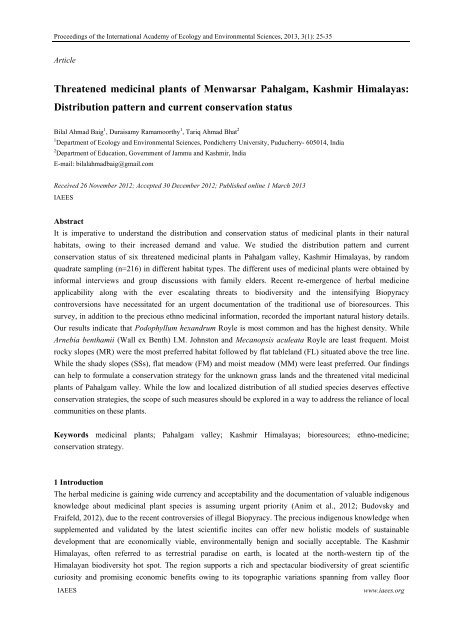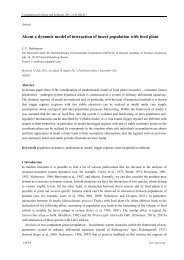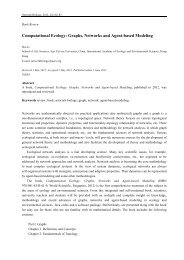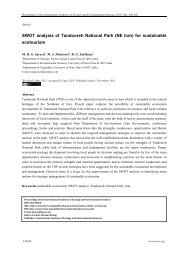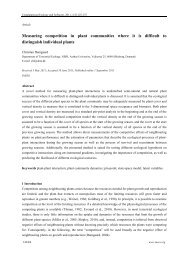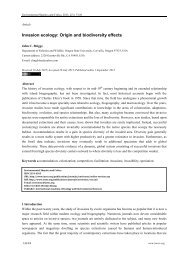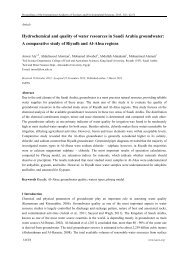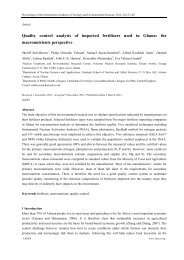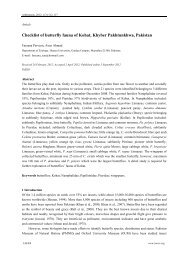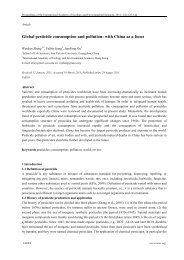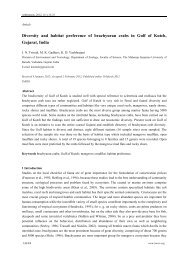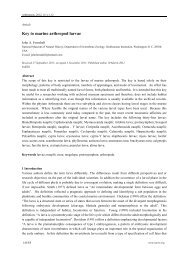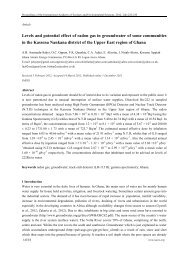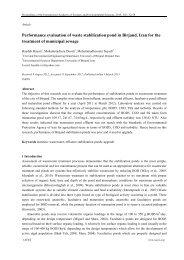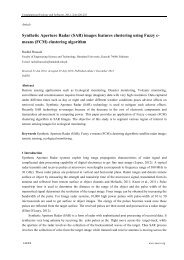Threatened medicinal plants of Menwarsar Pahalgam, Kashmir ...
Threatened medicinal plants of Menwarsar Pahalgam, Kashmir ...
Threatened medicinal plants of Menwarsar Pahalgam, Kashmir ...
You also want an ePaper? Increase the reach of your titles
YUMPU automatically turns print PDFs into web optimized ePapers that Google loves.
Proceedings <strong>of</strong> the International Academy <strong>of</strong> Ecology and Environmental Sciences, 2013, 3(1): 25-35<br />
Article<br />
<strong>Threatened</strong> <strong>medicinal</strong> <strong>plants</strong> <strong>of</strong> <strong>Menwarsar</strong> <strong>Pahalgam</strong>, <strong>Kashmir</strong> Himalayas:<br />
Distribution pattern and current conservation status<br />
Bilal Ahmad Baig 1 , Duraisamy Ramamoorthy 1 , Tariq Ahmad Bhat 2<br />
1 Department <strong>of</strong> Ecology and Environmental Sciences, Pondicherry University, Puducherry- 605014, India<br />
2 Department <strong>of</strong> Education, Government <strong>of</strong> Jammu and <strong>Kashmir</strong>, India<br />
E-mail: bilalahmadbaig@gmail.com<br />
Received 26 November 2012; Accepted 30 December 2012; Published online 1 March 2013<br />
IAEES<br />
Abstract<br />
It is imperative to understand the distribution and conservation status <strong>of</strong> <strong>medicinal</strong> <strong>plants</strong> in their natural<br />
habitats, owing to their increased demand and value. We studied the distribution pattern and current<br />
conservation status <strong>of</strong> six threatened <strong>medicinal</strong> <strong>plants</strong> in <strong>Pahalgam</strong> valley, <strong>Kashmir</strong> Himalayas, by random<br />
quadrate sampling (n=216) in different habitat types. The different uses <strong>of</strong> <strong>medicinal</strong> <strong>plants</strong> were obtained by<br />
informal interviews and group discussions with family elders. Recent re-emergence <strong>of</strong> herbal medicine<br />
applicability along with the ever escalating threats to biodiversity and the intensifying Biopyracy<br />
controversions have necessitated for an urgent documentation <strong>of</strong> the traditional use <strong>of</strong> bioresources. This<br />
survey, in addition to the precious ethno <strong>medicinal</strong> information, recorded the important natural history details.<br />
Our results indicate that Podophyllum hexandrum Royle is most common and has the highest density. While<br />
Arnebia benthamii (Wall ex Benth) I.M. Johnston and Mecanopsis aculeata Royle are least frequent. Moist<br />
rocky slopes (MR) were the most preferred habitat followed by flat tableland (FL) situated above the tree line.<br />
While the shady slopes (SSs), flat meadow (FM) and moist meadow (MM) were least preferred. Our findings<br />
can help to formulate a conservation strategy for the unknown grass lands and the threatened vital <strong>medicinal</strong><br />
<strong>plants</strong> <strong>of</strong> <strong>Pahalgam</strong> valley. While the low and localized distribution <strong>of</strong> all studied species deserves effective<br />
conservation strategies, the scope <strong>of</strong> such measures should be explored in a way to address the reliance <strong>of</strong> local<br />
communities on these <strong>plants</strong>.<br />
Keywords <strong>medicinal</strong> <strong>plants</strong>; <strong>Pahalgam</strong> valley; <strong>Kashmir</strong> Himalayas; bioresources; ethno-medicine;<br />
conservation strategy.<br />
1 Introduction<br />
The herbal medicine is gaining wide currency and acceptability and the documentation <strong>of</strong> valuable indigenous<br />
knowledge about <strong>medicinal</strong> plant species is assuming urgent priority (Anim et al., 2012; Budovsky and<br />
Fraifeld, 2012), due to the recent controversies <strong>of</strong> illegal Biopyracy. The precious indigenous knowledge when<br />
supplemented and validated by the latest scientific incites can <strong>of</strong>fer new holistic models <strong>of</strong> sustainable<br />
development that are economically viable, environmentally benign and socially acceptable. The <strong>Kashmir</strong><br />
Himalayas, <strong>of</strong>ten referred to as terrestrial paradise on earth, is located at the north-western tip <strong>of</strong> the<br />
Himalayan biodiversity hot spot. The region supports a rich and spectacular biodiversity <strong>of</strong> great scientific<br />
curiosity and promising economic benefits owing to its topographic variations spanning from valley floor<br />
IAEES<br />
www.iaees.org
26<br />
Proceedings <strong>of</strong> the International Academy <strong>of</strong> Ecology and Environmental Sciences, 2013, 3(1): 25-35<br />
through the terraced table lands (karewas) and dense forests elevating up to the snow caped alpine peaks, since<br />
ages through trial and error. People in the Himalayan region have learned and practiced the <strong>medicinal</strong> usage <strong>of</strong><br />
<strong>plants</strong> growing in their vicinity for treating various ailments.<br />
The <strong>medicinal</strong> use <strong>of</strong> <strong>plants</strong> by the nomadic and migratory tribes like Gujjars and Bakerwals in <strong>Kashmir</strong> has<br />
been documented previously (Navchoo and Bhat, 1994; Khan et al., 2004). However a periodic and continuous<br />
monitoring <strong>of</strong> these species in the wild Habitat is largely lacking with the available information being either<br />
qualitative (Dhar and Kachroo, 1983) or ethno-botanical (Dar et al., 1984; Ara and Naqshi, 1992). A perusal <strong>of</strong><br />
literature indicates that the documentation <strong>of</strong> ethno-botany <strong>of</strong> Ladakh (Bhattacharyya, 1989; Kaul et al., 1995),<br />
Doda (Kaul et al., 1994; Singh, 1995), Bhaderwah hills (Kapur, 1995), Little Tibet (Sharma, 1995), Uri sector<br />
(Lone, 2003), Muzaffarabad (Dar, 2003), and Samahni valley (Ishtiaq et al., 2006a, b, 2007) <strong>of</strong> <strong>Kashmir</strong><br />
Himalayas has been done. However, southern region <strong>of</strong> <strong>Kashmir</strong> in spite <strong>of</strong> being great repository <strong>of</strong> <strong>medicinal</strong><br />
<strong>plants</strong> (Dhar and Kachroo, 1983) remained unexplored in this regard. Therefore this study was undertaken in<br />
one <strong>of</strong> the alpine grass lands <strong>of</strong> <strong>Pahalgam</strong> valley, <strong>Kashmir</strong> to report on the distribution pattern, indigenous uses<br />
and availability <strong>of</strong> six threatened <strong>medicinal</strong> <strong>plants</strong>. i.e. Podophyllum hexandrum Royle, Picrorhiza kurroa<br />
Royle ex Benth, Aconitum heterophyllum Wall, Rheum emodi wall. ex Meissner, Arnebia benthamii (Wallich<br />
ex G. Don) I.M. Johnston and Mecanopsis aculeata Royle.<br />
2 Material and Methods<br />
2.1 Study site<br />
The study was carried out in plains and alpine grass lands <strong>of</strong> <strong>Menwarsar</strong> <strong>Pahalgam</strong> which is located at a<br />
distance <strong>of</strong> 26 km. from the headquarters <strong>of</strong> <strong>Pahalgam</strong>. The area extends between 34 0 05 / north and 75 0 22 / east<br />
at an altitude <strong>of</strong> 12205 ft. from the sea level. The diverse topographic features <strong>of</strong>fer many habitats and<br />
microhabitat types for a variety <strong>of</strong> herbal species to grow in the high altitude alpine forests. With the melting<br />
<strong>of</strong> snow the vegetation starts growing from early April and comes to its full bloom during June to September<br />
and starts dying out by the end <strong>of</strong> November. The area experiences heavy snowfall and remains under snow till<br />
March <strong>of</strong> next year.<br />
2.2 Methods<br />
Field surveys and structured interviews were used to illicit secret knowledge from the traditional communities<br />
inhabiting inaccessible habitats <strong>of</strong> the region. Field surveys were conducted in the various localities during<br />
2010 - 2012. Usually the survey in each locality started with the interview <strong>of</strong> elderly and experienced members.<br />
Often they were accompanied to the field for the identification <strong>of</strong> plant species and authentication <strong>of</strong> plant<br />
specimens collected from the habitats. Besides the common people <strong>of</strong> the localities were consulted who have<br />
used these plant species for health-care. In addition to our focused study frequency, abundance and IVI was<br />
obtained from random quadrates (n=36) <strong>of</strong> 1m 2 size (Misra, 1968). Analytical features for population study<br />
and distribution pattern like percentage frequency and density (<strong>plants</strong> per m 2 ) were calculated for each species<br />
across all sights. The mean values were taken to calculate Important Value Index (IVI) <strong>of</strong> individual species<br />
(Cottam and Curtis, 1956).<br />
Information and data pertaining to the traditional method <strong>of</strong> <strong>medicinal</strong> uses were obtained through a<br />
structured questionnaire survey conducted among the family elders <strong>of</strong> all visiting households (n=40). As all the<br />
three ethnic community tribes frequently use these herbs, it helped us to get a comparative account <strong>of</strong> the<br />
utilization <strong>of</strong> these plant species. In addition we also conducted unstructured informal interviews with the<br />
other family members (n=13, 8 males and 5 females) and group discussions (n=20) to further increase the<br />
horizons <strong>of</strong> our understanding on the local time, traditional use, part used, current nature <strong>of</strong> use (household<br />
consumption or commercial and recent trend in species status).<br />
IAEES<br />
www.iaees.org
Proceedings <strong>of</strong> the International Academy <strong>of</strong> Ecology and Environmental Sciences, 2013, 3(1): 25-35<br />
27<br />
Table 1 Characteristic features <strong>of</strong> selected <strong>medicinal</strong> plant species at <strong>Menwarsar</strong>, <strong>Pahalgam</strong>.<br />
Local name<br />
Current use within three<br />
communities<br />
Scientific Gujjar Chopan Bakerwal Altitude(m) Part<br />
Folklore uses CS(IUCN) Gujjar Chopan Bakerwal<br />
name<br />
used<br />
Podophyllum<br />
hexandrum<br />
Kakhri<br />
Wanwangun<br />
Kakhri<br />
2300-3900<br />
Fruit/ roots<br />
Septic wounds,<br />
gastric problems<br />
EN<br />
H<br />
Not used<br />
H<br />
Picrorhiza<br />
kurroa<br />
Kaurd<br />
Kaurd<br />
Kaurd<br />
3000-4400<br />
Rhizome/roots<br />
Considered to be<br />
favourite in Dilious<br />
dyspepsia, stomachic<br />
and laxative<br />
EN<br />
H<br />
H<br />
H<br />
Aconitum<br />
heterophyllum<br />
Patrees<br />
Patrees<br />
Patrees<br />
2900-3800<br />
Roots<br />
Bitter tonic especially<br />
given after malarial<br />
& other fevers & is<br />
CE<br />
H<br />
CEx<br />
CEx<br />
Rheum<br />
emodi<br />
Rahman<br />
Pambchalan<br />
Chutyal<br />
2800-4200<br />
Rhizome/leaves<br />
Root powder is<br />
sprinkled on ulcers,<br />
wounds for quick<br />
healing & is also used<br />
as laxative, tonic &<br />
EN<br />
H<br />
H<br />
H<br />
Arnebia<br />
benthamii<br />
Kahzaban<br />
Lailoot<br />
Kahzaban<br />
3200-4000<br />
Whole plant<br />
Given against high<br />
fevers & flowers are<br />
reported to have<br />
soothing effect on<br />
patients with heart<br />
CE<br />
H<br />
CEx<br />
CEx<br />
Mecanopsis<br />
aculeata<br />
Patharmaway<br />
Budhzadh<br />
Budhzadh<br />
2900-3800<br />
Whole plant<br />
Water extract <strong>of</strong><br />
whole herb used to<br />
wash wounds<br />
CE<br />
CEx<br />
Not used<br />
H<br />
Note: CS, conservation status: IUCN, international union for conservation <strong>of</strong> nature and natural resources: CE, critically endangered: EN, endangered: VU, vulnerable: H, household use: CEx,<br />
commercial exploitation.<br />
IAEES<br />
www.iaees.org
28<br />
Proceedings <strong>of</strong> the International Academy <strong>of</strong> Ecology and Environmental Sciences, 2013, 3(1): 25-35<br />
Table 2 Phytosociological Parameters <strong>of</strong> the threatened <strong>medicinal</strong> <strong>plants</strong> at menwarsar, <strong>Pahalgam</strong>.<br />
<strong>Menwarsar</strong><br />
Scientific name<br />
Density<br />
(<strong>plants</strong>/m 2 )<br />
Relative<br />
density(RD)<br />
Frequency (%)<br />
Relative<br />
frequency(RF)<br />
Important value<br />
Index (IVI) (%)<br />
P. hexandrum 1.73 0.41 66.66 0.38 0.90<br />
P. kurroa 1.2 0.28 40 0.23 0.59<br />
A. heterophyllum 0.56 0.13 23.33 0.13 0.31<br />
R. emodi 0.36 0.08 20 0.11 0.30<br />
A. benthamii 0.16 0.03 13.33 0.07 0.21<br />
M. aculeata 0.13 0.03 10 0.05 0.14<br />
Note: F, frequency; RF, relative frequency; IVI, Important valve Index.<br />
3 Results<br />
3.1 Density and distribution <strong>of</strong> species<br />
The distribution <strong>of</strong> species varied significantly among different habitats and none <strong>of</strong> the species occurred on all<br />
the habitats (Fig. 1 (a)-(f)). P. hexandrum was found on five different habitats, A. heterophyllum occurred on<br />
three while P. kurroa and R. emodi occurred on two habitats. The critically endangered M. aculeata recorded<br />
on only a single habitat type indicated its narrow distribution (Table 3). Flat table land and moist rocky slope<br />
were the preferred habitat types with each growing three species followed by moist meadows with two species<br />
while others grew only a single species each. The shady slopes regardless <strong>of</strong> their aspect also grow only a lone<br />
species i.e. P. hexandrum.<br />
Observation on the average distribution <strong>of</strong> the species across all sights revealed P. hexandrum to be most<br />
frequent (66.66%) followed by P. kurroa (40 %) and A. benthamii (13.33%) and M. aculeata (10%) as least<br />
frequent while A. heterophyllum (23.33%) and R. emodi (20%) were intermediate with moderate distribution<br />
(Table 2). While P. hexandrum (1.73 ind.m 2 ) and P. kurroa (1.2 ind.m 2 ) indicated highest density, the<br />
presence <strong>of</strong> P. kurroa in a single habitat type with the highest density emphasized its narrow and squeezed<br />
distribution. The least frequent M. aculeata had also the lowest density (0.13 ind. m 2 ).<br />
Important value Index (IVI) <strong>of</strong> each species was calculated to measure their numerical strength and assess<br />
their contribution to the total plant community. The highest IVI recorded is (0.90%) and lowest (0.14%) for P.<br />
hexandrum and M. aculeata, respectively.<br />
3.2 Folklore use <strong>of</strong> Assessed species<br />
The knowledge on the habitat distribution and <strong>medicinal</strong> use <strong>of</strong> these <strong>plants</strong> is maintained well within all the<br />
three ethnic tribes. The community elders and women folk have a handsome knowledge <strong>of</strong> the habitats, life<br />
history features, regeneration and uses <strong>of</strong> medicine <strong>plants</strong>. The continued belief <strong>of</strong> these communities on these<br />
high altitude easily accessible traditional <strong>medicinal</strong> <strong>plants</strong> and absence <strong>of</strong> alternative modern <strong>medicinal</strong><br />
facilities for them have greatly affected their source <strong>of</strong> medicine at this high altitude area. Data collected<br />
through the questionnaires highlighted the indigenous uses and reflected the collection, trade and reliance<br />
(Table 4) <strong>of</strong> these ethnic people on these <strong>medicinal</strong> <strong>plants</strong>.<br />
IAEES<br />
www.iaees.org
Proceedings <strong>of</strong> the International Academy <strong>of</strong> Ecology and Environmental Sciences, 2013, 3(1): 25-35<br />
29<br />
Table 3 Distribution, density, frequency and IVI <strong>of</strong> selected taxa across the different habitat types at <strong>Menwarsar</strong>, <strong>Pahalgam</strong>.<br />
Habitat type<br />
SS<br />
OS<br />
MR<br />
FL<br />
FM<br />
DS<br />
MM<br />
Scientific D F IVI D F IVI D F IVI D F IVI D F IVI D F IVI D F<br />
name<br />
P. hexandrum 2.86 26.3 5.5 0.32 10.01 1.31 1.71 13.2 5.6 _ _ _ _ _ _ 2.90 1.8 4.90 1.30 14.4<br />
P. kurroa _ _ _ _ _ _ 1.7 13.6 5.01 10.02 19 6.02 _ _ _ _ _ _ _ _<br />
A.<br />
heterophyllum<br />
_<br />
_<br />
_<br />
_<br />
_<br />
_<br />
0.42<br />
10.01<br />
2.2<br />
1.02<br />
16.2<br />
2.4<br />
0.38<br />
9.4<br />
1.90<br />
_<br />
_<br />
_<br />
_<br />
_<br />
R. emodi<br />
_ _ _ _ _ _ 1.5 17 7.1 1.6 20 7.8 _ _ _ _ _ _ _ _<br />
A. benthamii _ _ _ _ _ _ 0.92 11.4 2.6 0.82 10.1 2.3 _ _ _ _ _ _ _ _<br />
M. aculeata __ _ _ _ _ _ 0.13 10 0.14 _ _ _ _ _ _ _ _ _ _ _<br />
Note: SSA, shady slope ; OS, open gentle slope; MR, moist rocky slope; FL, flat tableland above tree line; FM, flat meadow ; Ds, dry shady slope: MM, moist meadow; D, density; F,<br />
frequency; IVI, Important valve Index; - (absent).<br />
IVI<br />
3.3<br />
_<br />
_<br />
_<br />
_<br />
_<br />
IAEES<br />
www.iaees.org
30<br />
Proceedings <strong>of</strong> the International Academy <strong>of</strong> Ecology and Environmental Sciences, 2013, 3(1): 25-35<br />
Table 4 Categorization <strong>of</strong> the assessed taxa in to different groups.<br />
Consumption<br />
Species name Rate in<br />
Rupees<br />
Mostly<br />
Household<br />
Mostly<br />
commercial<br />
Both Trade value<br />
(existing)<br />
Nature<br />
trade<br />
<strong>of</strong><br />
P. hexandrum 300 - 650 + _ _ Lowest Illegal<br />
P. kurroa 400 -800 + _ _ Low Illegal<br />
A.heterophyllum 4500 _ + _ High Illegal<br />
R. emodi 300 - 500 + _ _ Low Illegal<br />
A.benthamii 1200 - 1800 _ _ + High Illegal<br />
M. aculeata 800 - 1000 + _ + Low Illegal<br />
Note: Denotes the price which people get / kg from the middlemen and thus not reflect the market price.<br />
Table 5 Comparative account <strong>of</strong> population status (density/m 2 ) <strong>of</strong> selected<br />
plant species at selected localities <strong>of</strong> <strong>Pahalgam</strong>.<br />
Name <strong>of</strong> species <strong>Menwarsar</strong> Chhumnai Liderwart<br />
P. hexandrum 1.73 1.96 1.30<br />
P. kurroa 1.2 0.96 0.97<br />
A. heterophyllum 0.56 0.4 0.35<br />
R. emodi 0.36 0.46 0.58<br />
A. benthamii 0.16 0.13 _<br />
M. aculeata 0.13 0.1 _<br />
Note: (-) absent<br />
Almost all these plant species are used to cure common ailments like cough, cold, headache, asthma, fever,<br />
bronchitis and stomach pain by all the three ethnic tribes (Table 1). Furthermore species like A. heterophyllum<br />
are also used for some specific cases. A comparison <strong>of</strong> species indicates that A. heterophyllum and P. kurroa<br />
are the Prioritized <strong>medicinal</strong> <strong>plants</strong> for these people in terms <strong>of</strong> their ethno <strong>medicinal</strong> properties and uses.<br />
These <strong>plants</strong> have known antibacterial, anti- inflammatory and antipyretic properties, which together with their<br />
high market value make them a species <strong>of</strong> choice among all the three communities. These <strong>plants</strong> are also used<br />
frequently for their ethno veterinary applications by these tribes. Notable in this regard is R. emodi and P.<br />
kurroa which are used by the communities to cure different diseases <strong>of</strong> their livestock. Specifically the R.<br />
emodi is used to cure cough, dysentery, eye diseases, skin problems, constipation, ho<strong>of</strong> diseases, internal injury<br />
and broken horn <strong>of</strong> livestock by these communities while P. kurroa is used mostly to cure elementary<br />
disorders, in digestion, tonsils and intestinal worms by Bakerwals and Gujjars. Similarly P. hexandrum are<br />
specifically used for cuts, wounds and bone fracture.<br />
IAEES<br />
www.iaees.org
Proceedings <strong>of</strong> the International Academy <strong>of</strong> Ecology and Environmental Sciences, 2013, 3(1): 25-35<br />
31<br />
Fig. 1 (a) P. hexandrum<br />
Fig. 1 (b) P. kurroa<br />
Fig. 1 (c) A. heterophyllum<br />
IAEES<br />
www.iaees.org
32<br />
Proceedings <strong>of</strong> the International Academy <strong>of</strong> Ecology and Environmental Sciences, 2013, 3(1): 25-35<br />
Fig. 1 (d) R. emodi<br />
Fig. 1 (e) A. benthamii<br />
Fig. 1 (f) M. aculeata<br />
IAEES<br />
www.iaees.org
Proceedings <strong>of</strong> the International Academy <strong>of</strong> Ecology and Environmental Sciences, 2013, 3(1): 25-35<br />
33<br />
4 Discussion<br />
The IVI provides an excellent marker for understanding the status <strong>of</strong> distribution and availability across<br />
varying environmental and biotic conditions (Ram and Arya, 1991; Negi et al., 1992). This paper has<br />
described the distribution pattern and the current conservation status <strong>of</strong> threatened <strong>medicinal</strong> <strong>plants</strong> from a<br />
hitherto unknown <strong>Pahalgam</strong> valley, <strong>Kashmir</strong>. Relative values <strong>of</strong> the assessed species were tabulated and<br />
compared (Table 5) and based on this it was found P. hexandrum is widely distributed in different habitat<br />
types. The high frequency <strong>of</strong> P. hexandrum stems from its ability to grow in varied habitat types and complete<br />
the life cycle. In addition it is relatively lesser use and the part used frequently i.e. fruit also adds to its high<br />
frequency and density. However, the other species are highly localized and prone to grazing and trampling<br />
besides the part used being rhizomes and tubers. All these factors add to their low density and availability<br />
which is well reflected from our results.<br />
Species frequency and density are efficient ways to reveal the distribution and strength <strong>of</strong> any species in a<br />
landscape (Alhamad, 2006). Comparing these features with similar studies outside <strong>Pahalgam</strong> valley, it is<br />
evident that our values on density and distribution are low (Table 5). As no scientific reporting from the area<br />
has been done and there are no historical data on the distribution <strong>of</strong> the species from the upper reaches <strong>of</strong> the<br />
<strong>Pahalgam</strong> valley which historically have been used for grazing, it appears that the sampled species are the<br />
remnants <strong>of</strong> a previously large population which over the years have narrowed in their distribution due to a<br />
multitude <strong>of</strong> factors, many <strong>of</strong> which went unnoticed. Not all assessed species are preferred by animals, but<br />
because the area is grazed mostly by goats and sheep (personal observations) which are both non-selective in<br />
foraging (Chandrasekhar et al., 2007) which adds to the damage. Trampling is the other damaging factor which<br />
seems to have affected these species enormously in open areas and squeezed their distribution. In the<br />
elsewhere IHR, earlier studies (Nautiyal et al., 1997; Pandey et al., 2000) have also reported grazing, trampling,<br />
biotic interference and low seed viability to be responsible for the diminution population <strong>of</strong> these species. Our<br />
results also high lightened the low availability i.e. population size and habitat specificity <strong>of</strong> these species in the<br />
wild (Table 3). This has important conservation applications as the species with specific habitat requirements<br />
are at great risk than the species with broad habitat range (Samant et al., 1996); besides a minimum population<br />
size is required for the long term viability <strong>of</strong> rare and endangered species (Cunningham and Saigo, 1999).<br />
The communities include in this study are rural and migrate seasonally to the higher alpine areas for live<br />
stock grazing. The people have learnt the <strong>medicinal</strong> usage <strong>of</strong> <strong>plants</strong> that grow in their proximity in their ages<br />
(Khuroo et al., 2007). This was also evident from the information we calculated through the questionnaire<br />
survey and group discussions held. The wealth <strong>of</strong> practical knowledge on the various <strong>plants</strong>, their distribution<br />
and the traditional uses further strengthens the argument. However to represent best range <strong>of</strong> the ethno<br />
<strong>medicinal</strong> use <strong>of</strong> the various high altitude species, more efforts need to put in conducting a comprehension<br />
ethno botanical survey <strong>of</strong> the whole <strong>Pahalgam</strong> valley with due attention paid towards studying the<br />
conservation status <strong>of</strong> the important and rear <strong>medicinal</strong> herbs.<br />
The migratory pattern <strong>of</strong> the communities differs largely among the three tribes. Bakerwals are truly<br />
migratory and nomadic, Gujjars are semi-nomadic, but the <strong>Kashmir</strong>i Chopans are semi-sedentary. This<br />
division was also reflected in the difference in the utility <strong>of</strong> the <strong>plants</strong> among the three communities with the<br />
Chopans and the young ones using the least number <strong>of</strong> the assessed species that too in minimum number <strong>of</strong><br />
ways (Table 1).This adds to our observation that the young generation <strong>of</strong> the Chopans treat the folklore<br />
knowledge’s primitive and incompatible with the contemporary societal ideas. Consequently the older<br />
generation which harbors this wealth <strong>of</strong> the knowledge is generating and dying without passing on this<br />
invaluable legacy. This subtle change will bear a long term upshot on the maintenance and continuation <strong>of</strong> the<br />
IAEES<br />
www.iaees.org
34<br />
Proceedings <strong>of</strong> the International Academy <strong>of</strong> Ecology and Environmental Sciences, 2013, 3(1): 25-35<br />
indigenous Knowledge to subsequent generations which will greatly affect the way. These <strong>medicinal</strong> <strong>plants</strong> are<br />
used and managed by these communities.<br />
Acknowledgment<br />
Thanks to the Gujjars, Bakerwals and Chopans at the <strong>Pahalgam</strong> Valley for providing the accommodation, food<br />
and sharing the ethno botanical knowledge with us.<br />
References<br />
Alhamad MN. 2006. Ecological and species diversity <strong>of</strong> arid Mediterranean grazing land vegetation. Journal <strong>of</strong><br />
Arid Environments, 66: 698-715<br />
Anim AK, Laar C, Osei J, et al. 2012. Trace metals quality <strong>of</strong> some herbal medicines sold in Accra, Ghana.<br />
Proceedings <strong>of</strong> the International Academy <strong>of</strong> Ecology and Environmental Sciences, 2(2): 111-117<br />
Ara S, Naqshi AR.1992. Ethno botanical studies in Gurais valley. Journal <strong>of</strong> Economic and Taxonomic Botany,<br />
17: 657-678<br />
Bhattacharya A. 1989. Ethnobotanical observations in the Ladakh region <strong>of</strong> northern Jammu and <strong>Kashmir</strong><br />
State, India. Economic Botany, 25: 305-308<br />
Budovsky A, Fraifeld VE. 2012. Medicinal <strong>plants</strong> growing in the Judea region: network approach for<br />
searching potential therapeutic targets. Network Biology, 2(3): 84-94<br />
Chandrashekhar K, Rao KS, Maikhuri RK, Saxena KG. 2007. Ecological implications <strong>of</strong> traditional livestock<br />
husbandry and associated land use practices: a case study from the Trans Himalaya, India. Journal <strong>of</strong> Arid<br />
Environments, 69: 299-314<br />
Cottam G, Curtis IT. 1956. The use <strong>of</strong> distance measures in phytosociological sampling. Ecology, 37: 451-460<br />
Cunningham WP, Saigo B. 1999. Environmental Sciences: A Global Concern. Mcgraw-Hill, Boston, USA<br />
Dar G, Kachroo P, Buth HH. 1984. Ethno botany <strong>of</strong> <strong>Kashmir</strong>, Sind valley. Journal <strong>of</strong> Economic and<br />
Taxonomic Botany, 3: 668-675<br />
Dar ME. 2003. Ethno botanical uses <strong>of</strong> <strong>plants</strong> <strong>of</strong> Lawat District Muzaffarabad, Azad Jammu and <strong>Kashmir</strong>.<br />
Asian journal <strong>of</strong> Plant Sciences, 2: 680-682<br />
Dhar U, Kachroo P. 1983. Alpine Flora <strong>of</strong> <strong>Kashmir</strong> Himalayas. Scientific Publishers, Jodhpur, India<br />
Ishtiaq M, Khan M, Wafahi HA. 2006. An ethno <strong>medicinal</strong> inventory <strong>of</strong> <strong>plants</strong> used for family planning and<br />
sex diseases treatment in Samahni valley, (AK) Pakistan. Pakistan Journal <strong>of</strong> Botany, 9: 2546-2555<br />
Ishtiaq M, Hanif W, Khan M, et al. 2007. An etno<strong>medicinal</strong> survey and documentation <strong>of</strong> important <strong>medicinal</strong><br />
folklore food phytonims <strong>of</strong> flora <strong>of</strong> Samahni valley, (Azad <strong>Kashmir</strong>) Pakistan. Pakistan Journal <strong>of</strong> Botany<br />
10: 2241-2256<br />
Kapur SK. 1995. Traditionally important <strong>medicinal</strong> <strong>plants</strong> <strong>of</strong> Bhaderwah hills, Jammu province. Proceeding <strong>of</strong><br />
the international Conference Current Programme Aromatic Plants Research, (CPAPR’ 95), Calcutta, India,<br />
103-103<br />
Kaul MK, Sharma PK, Singh V. 1994. Contribution to the ethno-botany <strong>of</strong> paradise <strong>of</strong> Doda in (J & K) state,<br />
India. Bull. Bot. Survey India, 33: 267-275<br />
Kaul MK, Sharma PK, Singh V. 1995. Crude Drugs <strong>of</strong> Zanskar (Ladakh) used in Amchi System <strong>of</strong><br />
Traditionally Medicine. Glimpses <strong>of</strong> Indian Ethno Pharmacology, India, 163-172<br />
Khan ZS, Khuroo AA, Dar GH. 2004. Ethno <strong>medicinal</strong> survey <strong>of</strong> Uri, <strong>Kashmir</strong> Himalya. Indian Journal <strong>of</strong><br />
Traditional Knowledge, 3(4): 351-357<br />
Khuroo AA, Akhtar H, Malik AR, et al. 2007. Ethno-veterinary uses <strong>of</strong> some plant species by the Gujjar tribe<br />
<strong>of</strong> the <strong>Kashmir</strong> Himalaya. Asian Journal <strong>of</strong> Plant Science, 6(1): 148-152<br />
IAEES<br />
www.iaees.org
Proceedings <strong>of</strong> the International Academy <strong>of</strong> Ecology and Environmental Sciences, 2013, 3(1): 25-35<br />
35<br />
Lone FA. 2003. Folklore <strong>medicinal</strong> system <strong>of</strong> Uri sector <strong>Kashmir</strong> valley, India. Proceeding <strong>of</strong> the 2 nd World<br />
Congress on Biotechnology Development <strong>of</strong> Herbal Medicine, India, 91-91<br />
Misra R. 1968. Ecology Work Book. Oxford & IBH Publishing Co, New Delhi, India<br />
Nautiyal BP, Pandey N, Bhatt AB. 1997. Analysis <strong>of</strong> vegetation pattern in an alpine zone in North West<br />
Himalaya: a case study <strong>of</strong> Garhwal Himalaya with reference to diversity and distribution patterns.<br />
International Journal <strong>of</strong> Ecology & Environmental Sciences, 23: 49-65<br />
Navchoo IA, Bhat GM. 1994. Studies on the <strong>medicinal</strong> <strong>plants</strong> used by Gujjar, a backward tribe <strong>of</strong> Jammu and<br />
<strong>Kashmir</strong> Sahni KC. Advances in Plant Science and Research. Bishen Singh & Mahendra Singh, Dehradun,<br />
India, 191-203<br />
Negi GC, Rikhari HC, Singh SP. 1992. Phonological features in relation to growth forms and biomass<br />
accumulation in an alpine meadow <strong>of</strong> the Central Himalaya. Vegetatio, 101: 161-170<br />
Pandey N, Nautiyal BP, Bhatt AB. 2000. Studies on vegetation analysis, plant form and biological spectrum <strong>of</strong><br />
an alpine zone <strong>of</strong> north-west Himalaya. Tropical Ecology, 40: 163-166<br />
Ram J, Arya P. 1991. Plant forms and vegetational analysis <strong>of</strong> an alpine meadow <strong>of</strong> Central Himalaya, India.<br />
Proceedings <strong>of</strong> the Indian National Science Academy, 57: 311-318<br />
Samant SS, Dhar U, Rawal RS. 1996. Conservation <strong>of</strong> rare endangered <strong>plants</strong>: the context <strong>of</strong> Nanda Devi<br />
Biosphere Reserve In: Conservation and Management <strong>of</strong> Biological Resources in Himalaya (Ramakrishnan<br />
PS, ed). Oxford & IBH Publishing Co, New Delhi, India, 521-545<br />
Sharma GK. 1995. Medicinal flora <strong>of</strong> Ladakh (little Tibet). Flora and Fauna, 1: 105-106<br />
Singh V. 1995. Herbal remedies in traditionally medicine <strong>of</strong> the local valley in <strong>Kashmir</strong> Himalayas, India,<br />
round progress in <strong>medicinal</strong> <strong>plants</strong>. Ethno-Medicine and Pharmacology, 1: 63-71<br />
IAEES<br />
www.iaees.org


